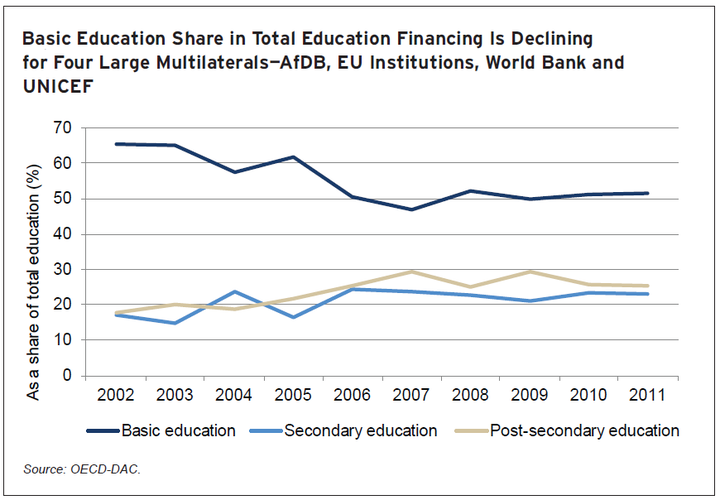The international community, and multilateral agencies in particular, have vast potential to mobilize financial resources to help fill the $26 billion annual funding gap for education, according to a new paper by the EFA Global Monitoring Report and the Brookings Institute.
The support of multilateral agencies for basic education is slowing compared with other sectors and bilateral donors. Unless multilateral aid is increased, there is a danger that growing support to new areas such as skills development will squeeze the scarce resources for basic education even further, to the detriment of the most disadvantaged.
These findings emerge from new analysis of the contributions of the six most important multilateral donors to education, released as a paper to inform the Learning for All meetings taking place this week at the United Nations General Assembly.
Our joint paper looks at five of the largest multilateral agencies in terms of total financing for education: the Asian Development Bank (ADB), the African Development Bank (AfDB), the European Union institutions, the World Bank and UNICEF. The contribution of the Global Partnership for Education (GPE) - the fifth-largest donor to education - is also analysed.
These agencies play a significant role in financing education, and have a unique capacity to pool funding and convene donors. This provides them with a number of opportunities to help make the final push to 2015 and beyond. Despite this potential, however, there is evidence that their support for basic education is waning.

Multilateral agencies currently allocate a much greater share of education aid to basic education than bilateral donors, although this share has been falling over the decade, partly because some agencies have increasingly prioritized higher education over basic education. The share of basic education in total official development assistance to education from the EU institutions, for example, fell from 50% to 43% over the decade; the AfDB's from 53% to 50%; the World Bank's from 63% to 55%. Overall, basic education's share of total education aid from multilaterals fell from 62% at the start of the decade to 51% in 2011.
Financial commitments need to be coordinated at the country level so that they can be used effectively and managed easily. There remains a significant amount of fragmentation of commitments, however, leaving some countries with too many donors and others with too few.
The Central African Republic, for example, has six donors. Tanzania has 23. Nearly half of the 41 countries in highest need have to coordinate with 15 or more donors to education. Moreover, seven countries have at least 20 donors, including a large proportion whose aid is identified as 'non-significant' as defined by the OECD's Development Assistance Committee (OECD-DAC). Bangladesh and Mozambique both have a large number of donors, among which there are nine non-significant donors.
This suggests that there is not an efficient division of labour among bilateral donors, and between bilateral and multilateral donors, to the detriment of countries with limited capacity to coordinate aid effectively from so many donors.
This lack of genuine coordination also makes it much harder for multilateral donors to fill gaps in financing and target countries with highest needs. Our new paper shows that multilateral donors do seem to prioritize countries in need more than bilateral donors do, but with some exceptions. The EU disburses only 40% of its basic education aid to the 41 countries in most need, for example; UNICEF, by comparison disburses 84% of its basic education aid to the same countries.
There is also substantial variation found in the volume of aid disbursed to countries in need. While it is estimated to cost $130 per year to provide a child with primary education of an acceptable quality in poorer countries, basic education aid disbursed per primary school age child ranges from $7 in the Democratic Republic of the Congo to $63 in Haiti. Among the 41 countries in need, 22 receive less than $10 per child from bilateral donors, even though needs are much larger. In only six of these 22 countries have multilaterals been able to significantly fill the gap.
Our paper provides five opportunities for action that could help enhance the role that multilateral agencies play.
Inspire demand for more support for basic education: Demand for basic education can be created in a positive manner as part of deep partnerships and dialogue at the country level. In-country technical capacity in basic education is an essential element in efforts to increase demand and effective support.
Organize high-level dialogue to target countries in need: Multilaterals must provide and attract high-level global leadership to mobilize and coordinate support to help countries in need. The GPE's board membership could be elevated to include high-level representation of donors, for example. The UN secretary-general's Global Education First Initiative could also support this dialogue, and establish recommendations for action.
Improve information and financial data: Multilateral agencies should support efforts to develop national education accounts. UNESCO's Institute for Statistics and International Institute for Educational Planning should help develop this approach and GPE could help with their coordination. Lessons could be taken from the development of national health accounts.
Catalyse domestic resources: Multilaterals could play a stronger role in helping countries mobilize resources and ensure that a sufficient proportion is allocated to human development, including education. Adopting and monitoring financing goals could help hold governments to account.
Tap into innovative finance: Education has not yet been a major beneficiary of innovative financing in development. Education could play a critical role in helping developing countries to navigate different types of innovative finance and facilitate partnerships between the government and private investors.
